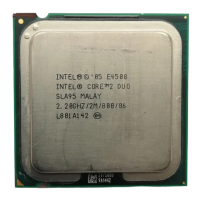Datasheet 67
Thermal Management
5.2.3 Platform Environment Control Interface (PECI)
The Platform Environment Control Interface (PECI) is a one-wire interface that provides
a communication channel between Intel processor and chipset components to external
monitoring devices. The processor implements a PECI interface to allow communication
of processor thermal information to other devices on the platform. The processor
provides a digital thermal sensor (DTS) for fan speed control. The DTS is calibrated at
the factory to provide a digital representation of relative processor temperature.
Averaged DTS values are read via the PECI interface.
The PECI physical layer is a self-clocked one-wire bus that begins each bit with a
driven, rising edge from an idle level near zero volts. The duration of the signal driven
high depends on whether the bit value is a Logic 0 or Logic 1. PECI also includes
variable data transfer rate established with every message. The single wire interface
provides low board routing overhead for the multiple load connections in the congested
routing area near the processor and chipset components. Bus speed, error checking,
and low protocol overhead provides adequate link bandwidth and reliability to transfer
critical device operating conditions and configuration information.
5.2.3.1 Fan Speed Control with Digital Thermal Sensor
Digital Thermal Sensor based fan speed control (T
FAN
) is a recommended feature to
achieve optimal thermal performance. At the T
FAN
temperature, Intel recommends full
cooling capability well before the DTS reading reaches T
j,max
. An example of this would
be T
FAN
= T
j,max
- 10ºC.
5.2.3.2 Processor Thermal Data Sample Rate and Filtering
The processor digital thermal sensor (DTS) provides an improved capability to monitor
device hot spots, which inherently leads to more varying temperature readings over
short time intervals. To reduce the sample rate requirements on PECI and improve
thermal data stability vs. time the processor DTS implements an averaging algorithm
that filters the incoming data. This filter is expressed mathematically as:
PECI(t) = PECI(t-1)+1/(2^^X)*[Temp - PECI(t-1)]
where:
• PECI(t) is the new averaged temperature
• PECI(t-1) is the previous averaged temperature
• Temp is the raw temperature data from the DTS
• X is the Thermal Averaging Constant (TAC)
The Thermal Averaging Constant is a BIOS configurable value that determines the time
in milliseconds over which the DTS temperature values are averaged (the default time
is 256 ms). Short averaging times will make the averaged temperature values respond
more quickly to DTS changes. Long averaging times will result in better overall thermal
smoothing but also incur a larger time lag between fast DTS temperature changes and
the value read via PECI.

